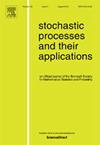Local time, upcrossing time and weak cutpoints of a spatially inhomogeneous random walk on the line
IF 1.1
2区 数学
Q3 STATISTICS & PROBABILITY
引用次数: 0
Abstract
In this paper, we study a transient spatially inhomogeneous random walk with asymptotically zero drift on the lattice of the positive half line. We give criteria for the finiteness of the number of points having exactly the same local time and/or upcrossing time and weak cutpoints (a point is called a weak cutpoint if the walk never returns to after its first upcrossing from to ). In addition, for the walk with some special local drift, we also give the order of the expected number of these points in Finally, if the local drift at is with for large enough, we show that, when properly scaled the number of these points in converges in distribution to a random variable with Gamma distribution. Our results answer three conjectures related to the local time, the upcrossing time, and the weak cutpoints posed by E. Csáki, A. Földes, P. Révész [J. Theoret. Probab. 23 (2) (2010) 624-638].
求助全文
约1分钟内获得全文
求助全文
来源期刊

Stochastic Processes and their Applications
数学-统计学与概率论
CiteScore
2.90
自引率
7.10%
发文量
180
审稿时长
23.6 weeks
期刊介绍:
Stochastic Processes and their Applications publishes papers on the theory and applications of stochastic processes. It is concerned with concepts and techniques, and is oriented towards a broad spectrum of mathematical, scientific and engineering interests.
Characterization, structural properties, inference and control of stochastic processes are covered. The journal is exacting and scholarly in its standards. Every effort is made to promote innovation, vitality, and communication between disciplines. All papers are refereed.
 求助内容:
求助内容: 应助结果提醒方式:
应助结果提醒方式:


